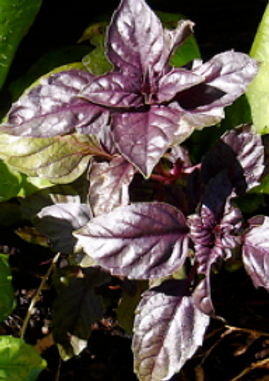Syrinx
Environmental Design/Build Consulting
Tulsi is "Holy Basil."
There are three types of Holy Basil, Latin name Ocimum sanctum. There is "Vana", Ocimum "gratissimum", and there are "Rama" and "Krishna", which are both "Ocimum teniflorum". O.t. for short. The type I have is Krishna Tulsi. It is a tender perennial that grows 3 feet tall with Purple leaves that have the flavor of cloves.
Tulsi is in the "Mint Family", the reason why you want to know this is that it needs
that same care as mint. Also, it will have the same pests as mint would.
Propagation- Sow directly in the rich soil in Full Sun location and lightly cover and firm soil down. keep most and warm until germination which takes about 2-3 weeks.
Cultivation - Grows well in containers and as a perennial will survive for several years. Pinch flowers back to continue production of purple leaves.
Properties- Eugenol, B-caryophyllene, sesquiterpenes, monoterpenes, ascorbic acid (vitamin C), carotene (Vitamin A), Calcium, Iron, and selenium, zinc, manganese and sodium as trace elements.
Culinary Uses- Known as "The Elixer of Life" Tulsi can be used anytime you would use basil. You can make a tea with the leaves that is said to be a healing balm for the body, mind, and spirit.
Medicinal Uses - Dr. Ralph Miller from India reports that Tulsi is a rich antioxidant renowned for its restorative powers. Relieves stress, bolsters immunity, enhanced stamina, provides support during cold season, promotes healthy metabolism, and is a natural immune-modulator. Relieves inflammation, lowers cholesterol, eliminates toxins, protects against radiation, prevents gastric ulcers, lowers fevers, improves digestion. Supports Heart, Blood vessels, liver and lungs and regulates blood pressure and blood sugar.

